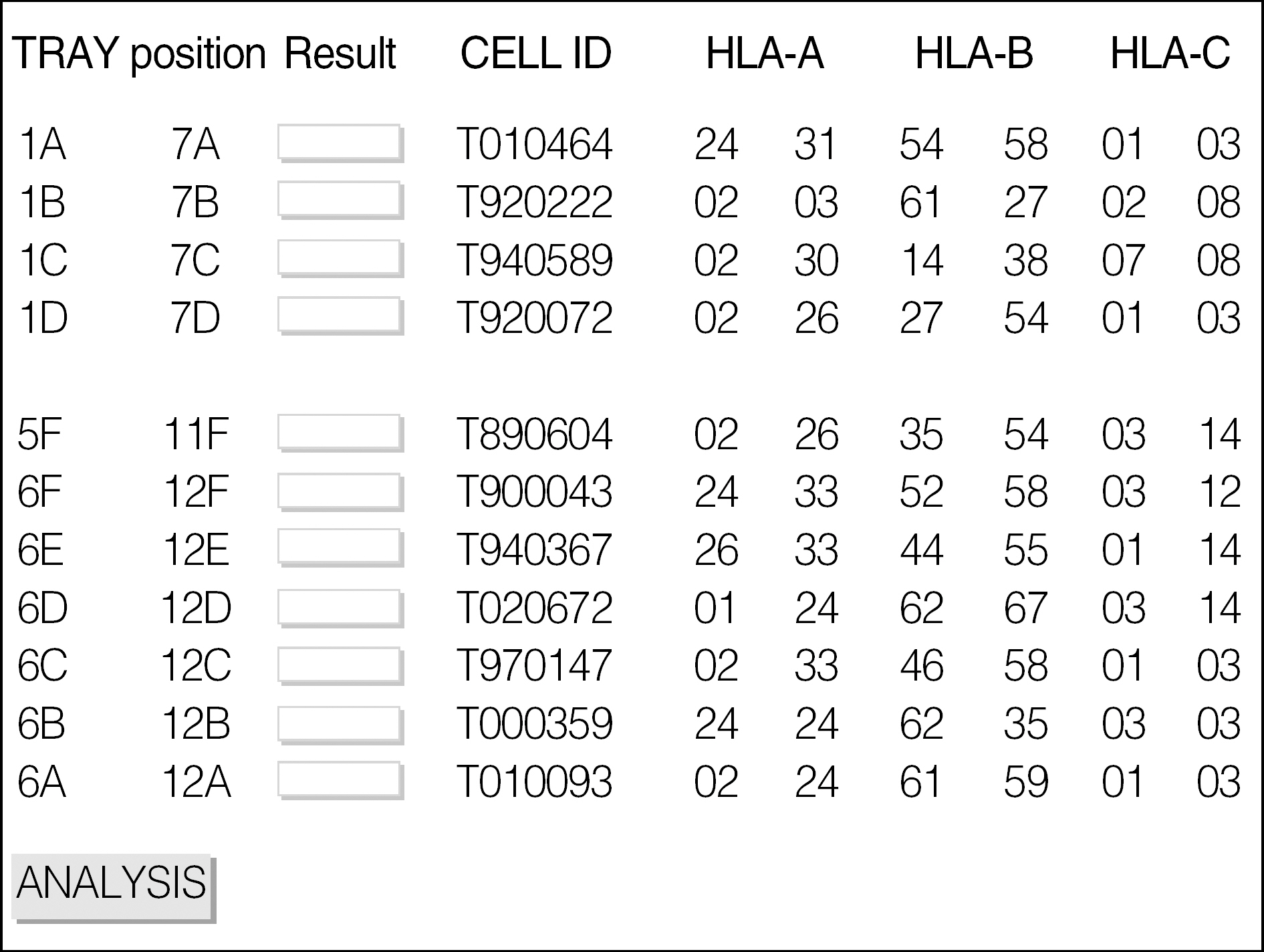Korean J Lab Med.
2007 Dec;27(6):458-463. 10.3343/kjlm.2007.27.6.458.
Development of a Web-based Program for the Identification of Human Leukocyte Antigen Antibody Specificities
- Affiliations
-
- 1Department of Laboratory Medicine, University of Ulsan College of Medicine and Asan Medical Center, Seoul, Korea. hboh@amc.seoul.kr
- 2Department of Computer Science Education, College of Education, Korea University, Seoul, Korea.
- KMID: 1781551
- DOI: http://doi.org/10.3343/kjlm.2007.27.6.458
Abstract
- BACKGROUND: Panel reactive antibody (PRA) test is used to determine whether a patient awaiting transplantation is previously sensitized. Tail analysis algorithm is widely used to identify antibody specificities, but it is very difficult to perform manually. METHODS: To develop a web-based program, PHP (5.1.2), Apache (2.0.55), and MySQL (5.0.22) were used. Tail analysis algorithm was applied to identify specificities, which analyzed statistically 2 x 2 tables representing reactivities to broad antigens, splits and cross reactive groups (CREG). Exploiting two CREG classifications of Rodey (R) and Takemoto (T), antibody specificities were identified by 3 methods (ABC, R-ABC, T-ABC) simultaneously. Performance of the system was evaluated using 159 samples that showed > or =6 PRA% by a lymphocytotoxicity assay. RESULTS: A web-based system that can identify HLA antibody specificities was implemented on www.koreanhla.com. Among 159 samples tested, antibody specificities were identified in 151 (95.0 %), but not in 8 samples with PRA >97%. Among the 151 samples, 110 showed broad or split specificities and 41 CREG specificities. CONCLUSIONS: We developed a web-based computer program for the identification of HLA antibody specificities. Accessible to everyone on the internet, this program should be of help in sharing PRA results among laboratories.
Keyword
MeSH Terms
Figure
Cited by 1 articles
-
Experience on Identification of Cross-Reactive Group Specificity Performed by Anti-human Globulin Panel Reactive Antibody Tests
Yong-Hak Sohn, Choong-Hwan Cha, Myeong Hee Kim, Sun-Young Ko, Heung-Bum Oh
Korean J Lab Med. 2008;28(5):362-370. doi: 10.3343/kjlm.2008.28.5.362.
Reference
-
1.Keown PA. The highly sensitized patient: etiology, impact, and management. Transplant Proc. 1987. 19:74–8.2.Braun WE. The alloimmunized patient: monitoring and therapeutics. Am J Med Sci. 1997. 313:279–82.
Article3.Kerman RH., Orosz CG., Lorber MI. Clinical relevance of anti-HLA antibodies pre and post transplant. Am J Med Sci. 1997. 313:275–8.
Article4.Fuller TC. Monitoring HLA alloimmunization. Analysis of HLA alloantibodies in the serum of prospective transplant recipients. Clin Lab Med. 1991. 11:551–70.5.Opelz G. Kidney transplantation in sensitized patients. Transplant Proc. 1987. 19:3737–41.6.Bradley BA., Gore SM. Council of Europe study of high sensitization in renal transplantation. Transplant Proc. 1987. 19:3742–3.7.Barama A., Oza U., Panek R., Belitsky P., MacDonald AS., Lawen J, et al. Effect of recipient sensitization (peak PRA) on graft outcome in haploidentical living related kidney transplants. Clin Transplant. 2000. 14:212–7.
Article8.Rodey GE., Revels K., Fuller TC. Epitope specificity of HLA class I alloantibodies: II. Stability of cross-reactive group antibody patterns over extended time periods. Transplantation. 1997. 63:885–93.9.Fuller TC., Phelan D., Gebel HM., Rodey GE. Antigenic specificity of antibody reactive in the antiglobulin-augmented lymphocytotoxicity test. Transplantation. 1982. 34:24–9.
Article10.Kim DW., Yang YS., Kim SH., Oh HY. Analysis of HLA alloantibodies in chronic renal failure patients. Korean J Clin Pathol. 1997. 17:163–72. (김대원, 양윤선, 김선희, 오하영. 만성신부전증환자의 HLA 동종항체분석. 대한임상병리학회지 1997;17: 163-72.).11.Duquesnoy RJ., White LT., Fierst JW., Vanek M., Banner BF., Iwaki Y, et al. Multiscreen serum analysis of highly sensitized renal dialysis patients for antibodies toward public and private class I HLA determinants. Implications for computer-predicted acceptable and unacceptable donor mismatches in kidney transplantation. Transplantation. 1990. 50:427–37.12.Zmijewski CM. Overview of detection and identification of HLA antibodies. Phelan DL, Mickelson EM, editors. , eds.ASHI laboratory manual. 3rd ed.American Society for Histocompatibility and Immunogenetics;1996. :I.D.1.p. 1–14.13.Zachary AA., Sholander JT., Delaney NL., Lucas DP. Evaluation of the humoral response in transplantation. Rose NR, Hamilton RG, editors. , eds.Manual of clinical laboratory immunology. 6th ed.Washington, DC: ASM Press;2002. p. 1153–63.14.McKenna RM., Takemoto SK. Improving HLA matching for kidney transplantation by use of CREGs. Lancet. 2000. 355:1842–3.
Article15.Transplantation immunology. In:. Abbas AK, Lichtman AH, editors. Cellular and molecular immunology. 5th ed.Philadelphia: W.B. Saunders;2003. p. 369–90.
Article16.Deka R., Panigrahi A., Aggarwal SK., Guleria S., Dash SC., Mehta SN, et al. Influence of pretransplant panel reactive antibodies on the posttransplant sensitization status. Transplant Proc. 2002. 34:3082–3.
Article17.Singh D., Kiberd BA., West KA., Kamal K., Balbontin F., Belitsky P, et al. Importance of peak PRA in predicting the kidney transplant survival in highly sensitized patients. Transplant Proc. 2003. 35:2395–7.
Article18.Konoeda Y., Terasaki PI., Wakisaka A., Park MS., Mickey MR. Public determinants of HLA indicated by pregnancy antibodies. Transplantation. 1986. 41:253–9.
Article19.Rodey GE., Neylan JF., Whelchel JD., Revels KW., Bray RA. Epitope specificity of HLA class I alloantibodies. I. Frequency analysis of antibodies to private versus public specificities in potential transplant recipients. Hum Immunol. 1994. 39:272–80.
Article20.Rodey GE., Fuller TC. Public epitopes and the antigenic structure of the HLA molecules. Crit Rev Immunol. 1987. 7:229–67.21.Takemoto S., Gjertson DW., Terasaki PI. HLA matching: a comparison of conventional and molecular approaches. Terasaki PI, Cecka JM, editors. Clinical Transplants. Los Angeles: UCLA Tissue Typing Laboratory;1992. p. 413–34.22.Hwang SH., Oh HB., Yang JH., Kwon OJ., Shin ES. Distribution of HLA-A, B, C allele and haplotype frequencies in Koreans. Korean J Lab Med. 2004. 24:396–404. (황상현, 오흥범, 양진혁, 권오중, 신은순. 한국인의 HLA-A, -B, -C 대립유전자와일배체형분포. 대한진단검사의학회지 2004;24: 396-404.).23.Roh EY., Kim HS., Kim SM., Lim YM., Han BY., Park MH. HLA-A, -B, -DR allele frequencies and haplotypic associations in Koreans defined by generic-level DNA typing. Korean J Lab Med. 2003. 23:420–30. (노은연, 김현수, 김선미, 임영미, 한복연, 박명희. DNA 형별검사에의한한국인의 HLA-A, -B, -DR 형별및일배체형의분포. 대한진단검사의학회지 2003;23: 420-30.).
- Full Text Links
- Actions
-
Cited
- CITED
-
- Close
- Share
- Similar articles
-
- Experience on Identification of Cross-Reactive Group Specificity Performed by Anti-human Globulin Panel Reactive Antibody Tests
- Experience of HLA Antibody Testing in the International Serum Exchange Program
- HLA-A, B Antibodies in Korean Pregnant Women
- Development of decision support system for antibody identification
- Development and Evaluation of a Web-based Support Program for the Maternal Role of Primiparas



